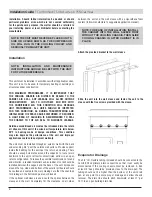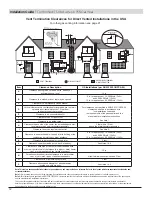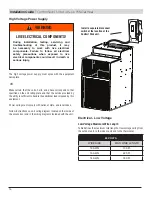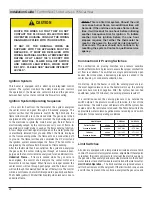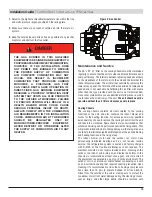
Installation Guide
|
Comfort Pack T Series
with up to
95% Gas Heat
18
Abnormal Functions
• Interrupted Thermostat Call for Heat
– If the thermostat demand
for heat is removed before the flame is recognized, the control will
run the venter motor for the post purge period and de-energize
all outputs. If the thermostat demand for heat is removed after
successful ignition, the control will de-energize the gas valve, run
the venter motor through post purge, and run the blower motor on
heat speed for the selected delay off time.
• Soft Lockout
– The control shall not initiate a call for heat or call
for continuous fan while in lockout. The control will still respond
to an open limit and undesired flame. Lockout shall automatically
reset after one hour. Lockout may be manually reset by removing
power from the control for more than one second or removing
the thermostat call for heat for more than one and less than 20
seconds.
• Hard Lockout
– If the control detects a fault on the control board,
the status LED will be de-energized, and the control will lockout as
long as the fault remains. A hard lockout will automatically reset if
the hardware fault clears.
• Power Interruption
– During a momentary power interruption or at
voltage levels below the minimum operating voltage for line voltage
the system will self-recover without lockout when voltage returns
to the operating range. During a momentary power interruption of
low voltage the board will enter a soft lockout. Power interruptions
of less than 80ms shall not cause the control to change operating
states. Power interruptions greater than 80ms may cause the
control to interrupt the current operating cycle and re-start.
• Ignition Retry
– If flame is not established on the first trial for
ignition, the control de-energizes the gas valve and the venter
motor remains energized for an inter-purge period of 30 seconds.
The spark and gas valve are then re-energized, and the control
initiates another trial for ignition. If flame is not established on the
second trial for ignition, the control de-energizes the gas valve,
energizes the blower motor on heat speed, and venter motor
remains energized. The blower motor is shut off after 180 seconds.
When the blower motor de-energizes, the spark and gas valve are
re-energized and the control initiates another trial for ignition. (This
blower delay is a self-healing feature for an open auxiliary limit
switch). If flame is not established on the third trial for ignition, the
control de-energizes the gas valve, and the venter motor remains
energized for an inter-purge period of 20 seconds. The control
then re-energizes the gas valve and spark and initiates another trial
for ignition. If flame is not established on the fifth trial for ignition
(initial try plus 4 re-tries), the control de-energizes the gas valve
and goes into lockout. The control goes to one flash on the green
LED to indicate ignition failure lockout.
• Condensate Freeze Protection
– If the burner compartment
temperature falls to 41°F ± 9°F, the safety thermostat switch will
close and energize the condensate heater. The heater will remain
energized until the burner compartment reaches a temperature of
68°F ± 9°F. This heater will operate independently of the furnace's
standard sequence of operation.
Installation Codes
These units must be installed in accordance with local building
codes. In the absence of local codes, in the United States, the units
should be installed in accordance with the National Fuel Gas Code
(latest edition). A Canadian installation must be in accordance with
the CAN/CGA-B149.1 and B149.2 Installation Code for Gas Burning
Appliances and Equipment. These codes are available from CSA
Information Services, 1-800-463-6727. Local authorities having
jurisdiction should be considered before installation is made to
verify local codes and installation procedure requirements.
High Altitude Operation
If the heater is being installed at an elevation above 2000 ft.
(610m), the input rate will have to be derated. This is done by
adjusting the valve outlet pressure (See page 22). Adjusting the
valve outlet pressure is done after the heater is in operation; follow
the instructions below. (see Figure 1).
Figure 1
Heat Section Burner/Control Compartment
(Note: Unit side panel is not shown for clarity; the side panel is not
removable. Access to the burner/control compartment is through
the rear access panel.)
Содержание Comfort Pack CP9 T Series
Страница 2: ...2...





